- Back to Home »
- An unprecedented engineering feat
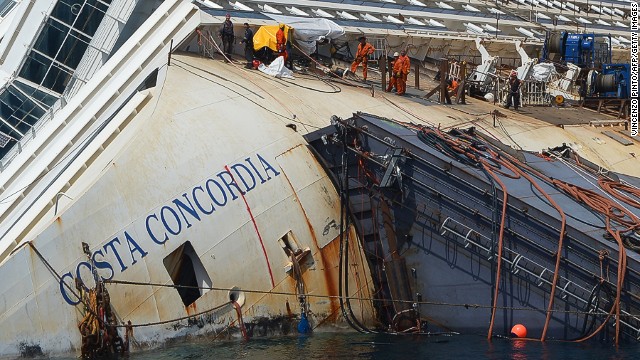 Salvage workers prepare the Costa Concordia cruise ship on August 23, 2013 at Giglio Island. The ship will be raised in September near the Italian island where it still lies. The cruise liner made global headlines when it turned on its side after striking rocks on January 13, 2012.
Salvage workers prepare the Costa Concordia cruise ship on August 23, 2013 at Giglio Island. The ship will be raised in September near the Italian island where it still lies. The cruise liner made global headlines when it turned on its side after striking rocks on January 13, 2012. 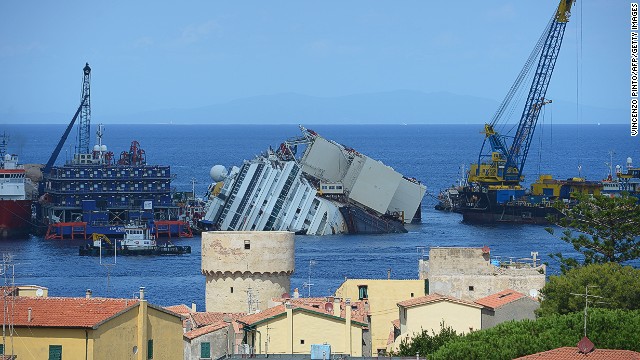 A general view of the cruise liner. Five people were convicted of multiple manslaughter and causing personal injury, including the cruise ship's captain, Francesco Schettino.
A general view of the cruise liner. Five people were convicted of multiple manslaughter and causing personal injury, including the cruise ship's captain, Francesco Schettino. 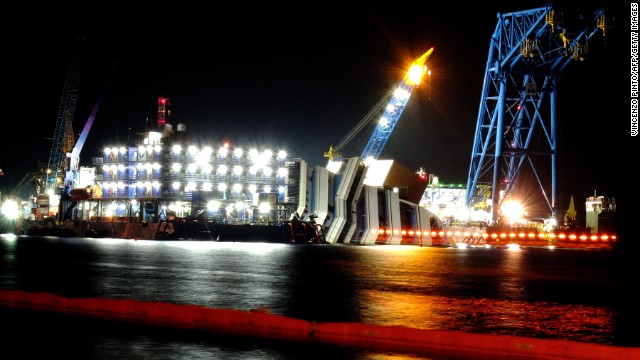 Salvage workers continue recovery operations at the site on June 15, 2013. Thirty-two people died in the tragedy and another 150 people were injured in the evacuation of the ship -- 65 of them seriously.
Salvage workers continue recovery operations at the site on June 15, 2013. Thirty-two people died in the tragedy and another 150 people were injured in the evacuation of the ship -- 65 of them seriously. 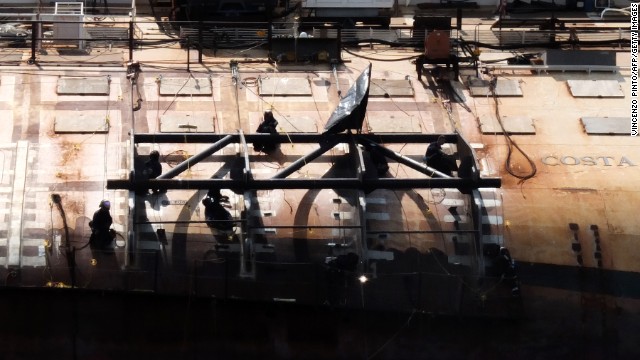 Technicians work to salvage the half-submerged ship on July 7, 2013. Nearly 500 workers are involved in an operation to remove the wreck while protecting the marine environment.
Technicians work to salvage the half-submerged ship on July 7, 2013. Nearly 500 workers are involved in an operation to remove the wreck while protecting the marine environment.  Giant hollow boxes have been attached to the side of the ship, seen on May 27, 2013. The plan is to eventually haul the vessel upright and then attempt to refloat it with the aid of the compartments.
Giant hollow boxes have been attached to the side of the ship, seen on May 27, 2013. The plan is to eventually haul the vessel upright and then attempt to refloat it with the aid of the compartments.  A commemorative plaque honoring the victims of the cruise disaster is unveiled in Giglio on January 14, 2013.
A commemorative plaque honoring the victims of the cruise disaster is unveiled in Giglio on January 14, 2013. 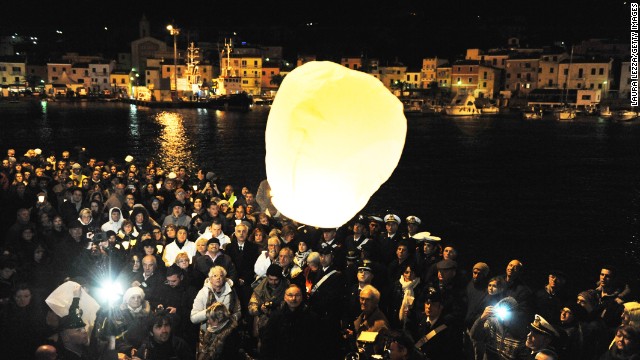 Survivors, grieving relatives and locals release lanterns into the sky in Giglio after a minute of silence on January 13, 2013, marking the one-year anniversary of the shipwreck. The 32 lanterns -- one for each of the victims -- were released at 9:45 p.m. local time, the moment of impact.
Survivors, grieving relatives and locals release lanterns into the sky in Giglio after a minute of silence on January 13, 2013, marking the one-year anniversary of the shipwreck. The 32 lanterns -- one for each of the victims -- were released at 9:45 p.m. local time, the moment of impact.  A man holds an Italian flag on his balcony overlooking the port of Giglio on January 13, 2013.
A man holds an Italian flag on his balcony overlooking the port of Giglio on January 13, 2013. 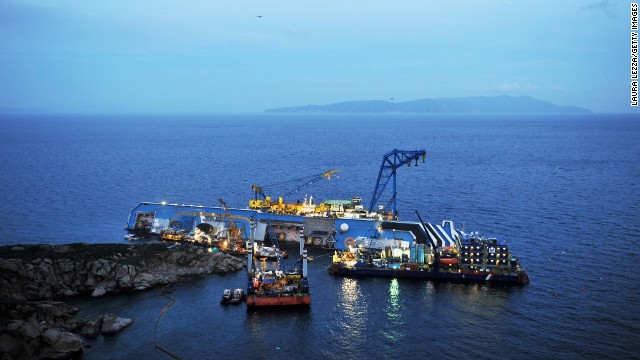 The sunken Costa Concordia remains in the calm blue waters on January 12, 2013, the day before the disaster's one-year anniversary.
The sunken Costa Concordia remains in the calm blue waters on January 12, 2013, the day before the disaster's one-year anniversary. 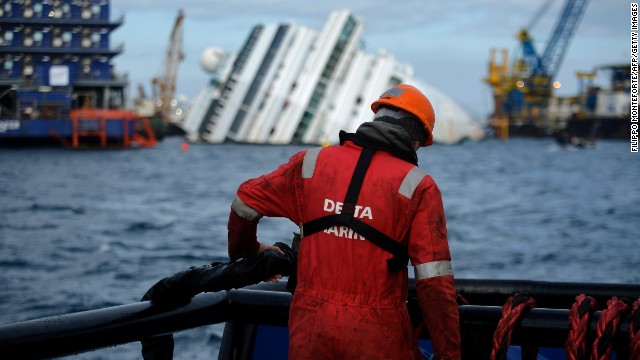 A man works in front of the shipwreck on January 12, 2013.
A man works in front of the shipwreck on January 12, 2013.  A couple walks along the port of Giglio at night on January 12, 2013.
A couple walks along the port of Giglio at night on January 12, 2013. 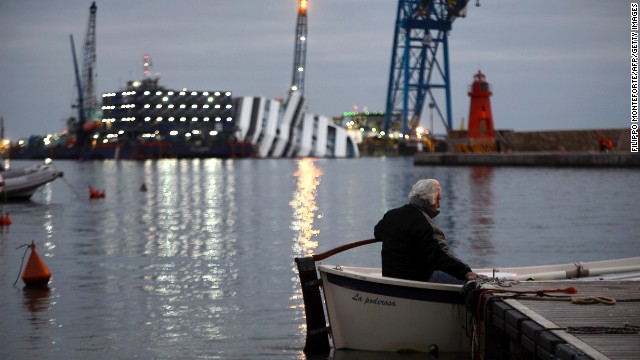 A man sits in his boat in front of the half-submerged cruise ship on January 8, 2013.
A man sits in his boat in front of the half-submerged cruise ship on January 8, 2013. 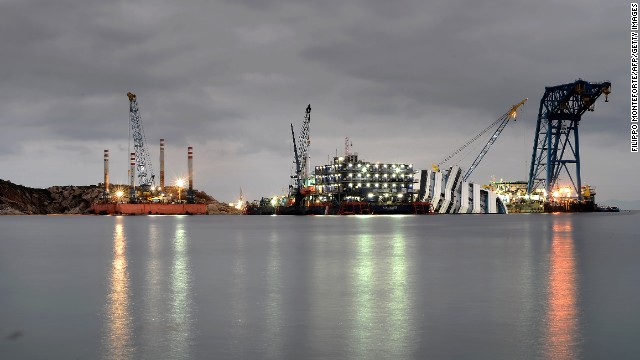 Cranes and floating decks surrounding the ship light up the dusk sky on January 9, 2013.
Cranes and floating decks surrounding the ship light up the dusk sky on January 9, 2013. 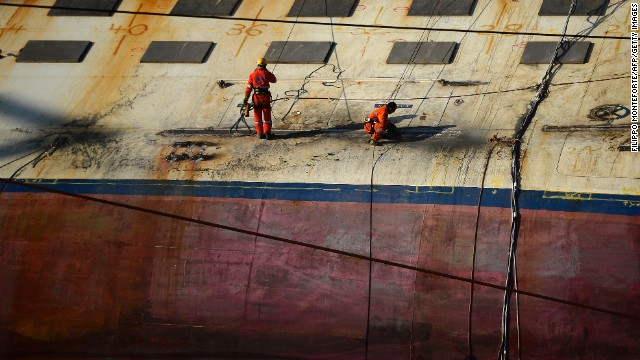 Workers stand on the edge of the ship on January 8, 2013.
Workers stand on the edge of the ship on January 8, 2013. 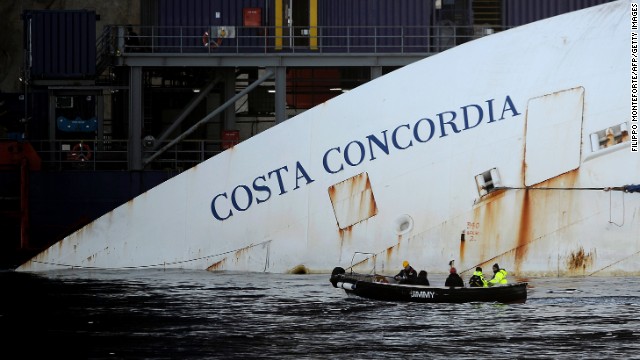 A crew passes by the hulking remains on January 7, 2013.
A crew passes by the hulking remains on January 7, 2013. 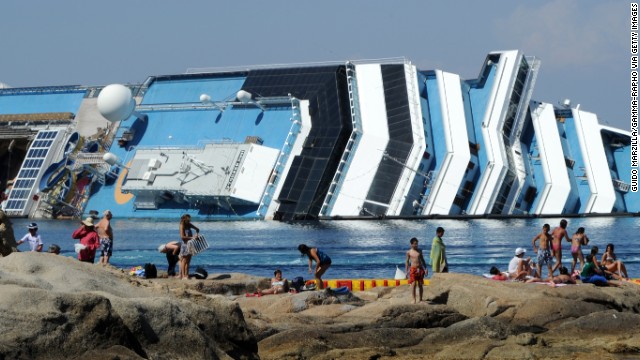 People enjoy a day in the sun with a view of the cruise liner on July 1, 2012.
People enjoy a day in the sun with a view of the cruise liner on July 1, 2012.  Technicians work during an operation to pump out 2,380 tons of fuel from the stricken ship on January 25, 2012.
Technicians work during an operation to pump out 2,380 tons of fuel from the stricken ship on January 25, 2012. 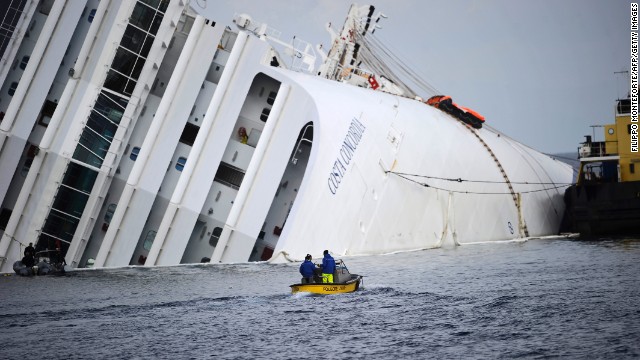 Workers head toward the stricken cruise ship on January 23, 2013.
Workers head toward the stricken cruise ship on January 23, 2013. 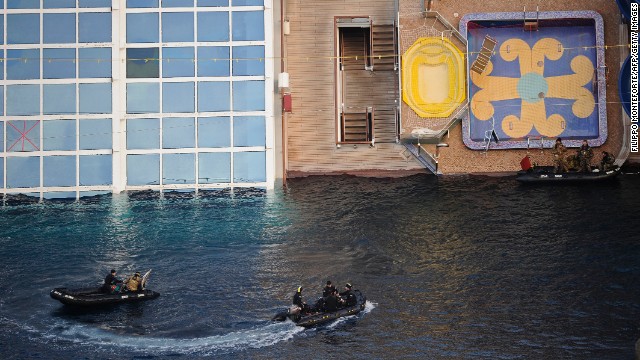 Military rescue workers approach the cruise liner on January 22, 2012.
Military rescue workers approach the cruise liner on January 22, 2012. 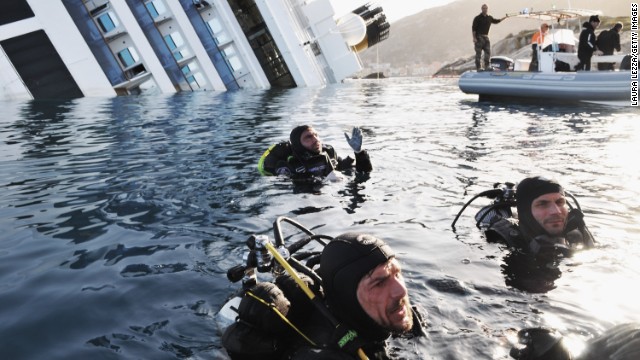 Members of the Italian coast guard conduct a search-and-rescue mission on January 21, 2012.
Members of the Italian coast guard conduct a search-and-rescue mission on January 21, 2012.  Rescue operations to search for missing people resumed on January 20, 2012, after being suspended for a third time as conditions caused the vessel to shift on the rocks.
Rescue operations to search for missing people resumed on January 20, 2012, after being suspended for a third time as conditions caused the vessel to shift on the rocks. 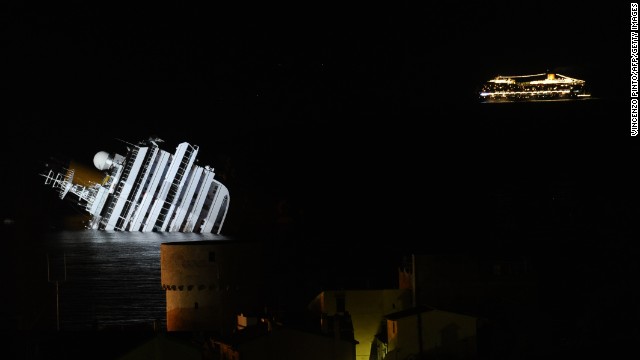 The Costa Serena, the sister ship of the wrecked Costa Concordia, passes by on January 18, 2012.
The Costa Serena, the sister ship of the wrecked Costa Concordia, passes by on January 18, 2012. 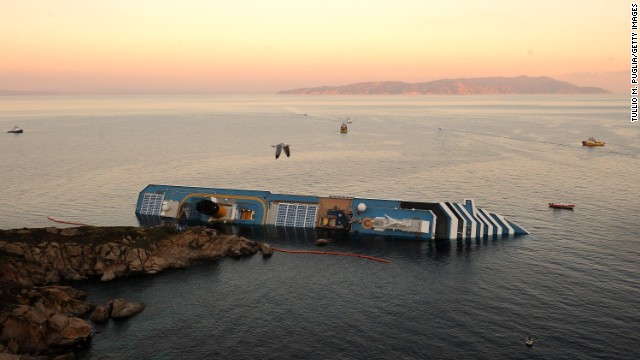 A bird flies overhead the Costa Concordia on January 18, 2012. Rescue operations were suspended as the ship slowly sank farther into the sea.
A bird flies overhead the Costa Concordia on January 18, 2012. Rescue operations were suspended as the ship slowly sank farther into the sea. 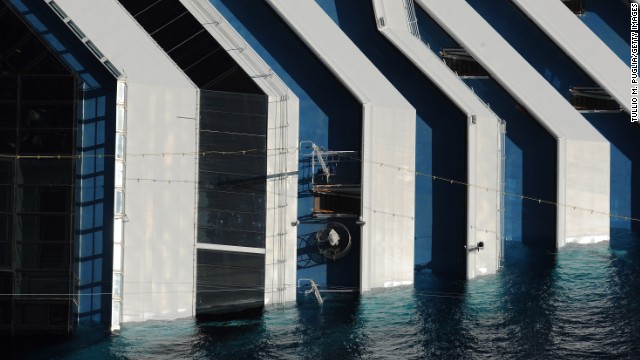 The ship was sailing a few hundred meters off the rocky Tuscan coastline.
The ship was sailing a few hundred meters off the rocky Tuscan coastline.  An Italian coast guard helicopter flies over Giglio's harbor on January 16, 2012.
An Italian coast guard helicopter flies over Giglio's harbor on January 16, 2012.  Rescuers search the waters near the stricken ship on January 16, 2012.
Rescuers search the waters near the stricken ship on January 16, 2012. 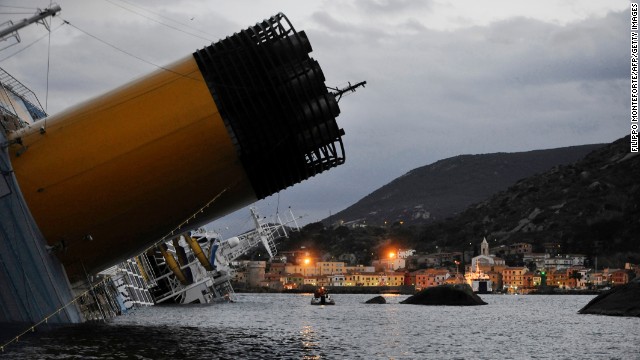 The Concordia, pictured on January 15, 2012, was on a Mediterranean cruise from Rome when it hit rocks off the coast of Giglio.
The Concordia, pictured on January 15, 2012, was on a Mediterranean cruise from Rome when it hit rocks off the coast of Giglio. 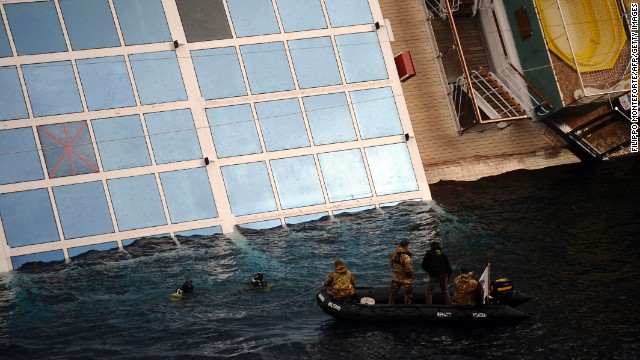 Divers inspect the Costa Concordia on January 15, 2012.
Divers inspect the Costa Concordia on January 15, 2012. 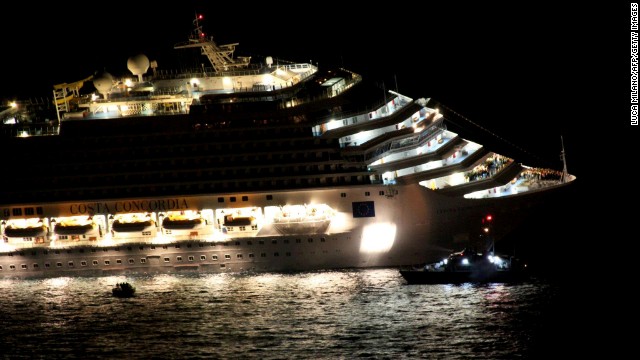 The ship starts keeling over early on January 14, 2012. Evacuation efforts started promptly but were made "extremely difficult" by the position of the listing ship, officials said.
The ship starts keeling over early on January 14, 2012. Evacuation efforts started promptly but were made "extremely difficult" by the position of the listing ship, officials said. 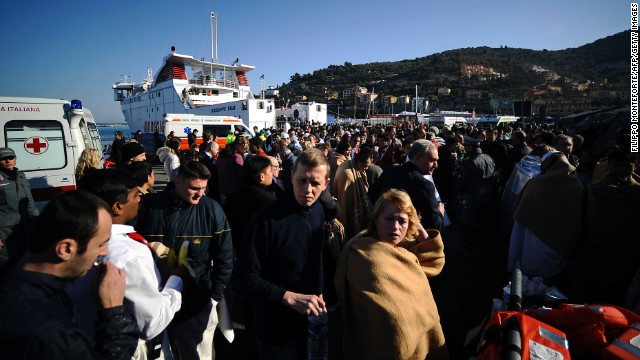 Rescued passengers arrive at Porto Santo Stefano, Italy, on January 14, 2012. The Costa Concordia was carrying 3,200 passengers and 1,000 crew members.
Rescued passengers arrive at Porto Santo Stefano, Italy, on January 14, 2012. The Costa Concordia was carrying 3,200 passengers and 1,000 crew members. 
1

2

3

4

5

6

7

8

9

10

11

12

13

14

15

16

17

18

19

20

21

22

23

24

25

26

27

28

29

30
- Crews will start rotating the Costa Concordia on Monday
- It's a massive undertaking that has never been done with such a large ship
- The bodies of two victims are believed to be still in the wreckage
- So are a mix of toxins that would be devastating if they leak into the water
Giglio, Italy (CNN) -- It sounds counterintuitive: in order to salvage the massive cruise ship that ran aground last year, crews will sink portions of it deeper underwater.
The rotation of the Costa Concordia cruise ship is a massive undertaking that is scheduled to start off Italy's coast at 6 a.m. Monday (12 a.m. ET).
The ship will be pulled off the seabed and rotated onto giant platforms 30 meters below the water level. Areas of the ship that have been dry for months will be submerged and filled with water.
It's a process known as "parbuckling," and it's become a household term in Giglio, the tiny island that was transformed when the Costa Concordia ran aground off its coast in January 2012.
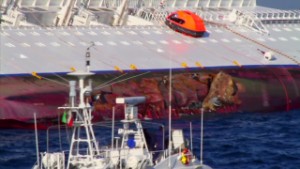 Risky attempt to salvage Costa Concordia
Risky attempt to salvage Costa Concordia  2012: Divers examine Concordia wreckage
2012: Divers examine Concordia wreckage  Incredible drone video of Costa Concordia
Incredible drone video of Costa Concordia  Costa Concordia survivor relives escape
Costa Concordia survivor relives escape A ship this large and this heavy -- weighing 114,000 tons -- has never been parbuckled before.
Normally, crews would blow up the ship or take it apart on site.
But officials say that's not an option with the Costa Concordia, because the ship is filled with toxins, and because there are two bodies still believed to be either trapped between the ship and its rocky resting place or somewhere deep in the ship's hollow hull.
What's inside of wrecked cruise ship?
Waiter, passenger still missing
The two missing victims from the cruise ship disaster, which killed 32 people, are Russel Rebello of India, and Maria Grazia Trecarichi of Sicily, Italy.
Rebello, 33, was a cruise waiter who was last seen helping passengers off the ship.
Trecarichi was on the cruise to celebrate her 50th birthday with her 17-year-old daughter, one of thousands of people who survived the deadly shipwreck. On Monday, her daughter and husband will watch crews try to rotate the ship and, hopefully, find Trecarichi's remains.
Technicians and salvage managers from all over the world will be watching closely to see what goes wrong and what works.
"It will set the new standard for maritime salvage," Giovanni Ceccarelli, the project's engineering manager, told CNN.
Hundreds of people and dozens of companies have collaborated on the preparations, but the parbuckling will come down to 12 people, including the salvage master and specialized technicians, who will be guiding the operation from inside a prefabricated control room set up on a tower on a barge in front of the ship.
A complex operation
Parbuckling the ship could be done in a day or so -- provided the weather conditions agree. So far, they seem to be, officials said on a website tracking the operation.
It's a major turning point in a salvage operation that has cost the Costa Crociere company, owned by American firm Carnival Cruises, more than $600 million -- so far.
Tall towers anchored onto the rocky shoreline between the ship and the island have been fitted with computer-operated pulley-like wheels.
As the rotation begins, the wheels will guide thick cables and chains pulling the middle third of the ship from under its belly toward Giglio island.
At the same time, more chains and cables attached to hollow boxes that have been welded onto the ship's port side will pull the ship from the top toward the open sea.
After about four to six hours, the pulleys and cables will be rendered useless as gravity takes over and the ship essentially finishes the process, relying on the buoyant boxes alone to control the speed at which it rights itself.
Technicians will pump compressed air into the boxes to control the water levels, which will create buoyancy to slow the ship's rotation until it eventually comes to rest on makeshift "mattresses" put in place on the steel platforms.
If all goes well, the ship will lift off the rocks in one piece and not separate or break apart. If things go wrong, it could be disastrous.
Has master mariner in charge of salvage met his match?
Toxins, other items onboard
The ship contains a mix of toxins that would be devastating for the environment if leaked into the water, which would happen if the ship breaks apart or sinks.
According to the Costa Concordia's inventory list published in the Italian press and confirmed by Costa, thousands of liters of thick lubricants, paints, insecticides, glue and paint thinners were on board before it set sail three hours before it crashed.
There are also 10 large tanks of oxygen and 3,929 liters of carbon dioxide.
That's not all.
Refrigerators filled with milk, cheese, eggs and vegetables have been closed tight since the disaster.
And the freezers that have not burst under the water pressure are still locked with their rotting thawed contents sealed inside, including 1,268 kilograms of chicken breasts, 8,200 kilograms of beef, 2,460 kilograms of cheese and 6,850 liters of ice cream.
What's next
As the ship rotates, much more water will enter the ship than will spill out, salvage operators say. That fresh seawater will dilute some of the toxic mix, but it will all eventually have to be purified and pumped out before the ship is towed across the sea for dismantling at its final port -- a location that remains to be determined.
In the meantime, the salvage operators have set up two rings of oil booms with absorbent sponges and skirts that extend into the water to catch any debris that may escape.
Once the ship is upright, it will be months before the contents are removed, likely not until it reaches its final port.
At that time, Costa officials say they intend to remove personal effects from the state rooms and return those to each passenger, no matter how soggy the contents might be. None of that is expected to happen before next summer.
Meanwhile, captain Francesco Schettino, who misguided the ship off course, faces charges of manslaughter, causing a maritime disaster and abandoning ship with passengers still on board. His trial resumes in Grosseto on September 23.
A guarantee for the nervous cruiser
A turning point
Once the ship is upright, the salvage operation changes dramatically.
A tiny robotic submarine with surveillance cameras will survey the damaged side of the ship and create the models they need to plan for the next phase of operations.
"It will look like a high-impact car accident when it is lifted," Nick Sloane, the salvage master, told CNN. "It won't be pretty."
For days, salvage workers have been running simulations and testing their equipment. A steady hum of machinery out on the wreckage site could be heard night and day in Giglio harbor.
The ship looks nothing like it did months ago, when it seemed gigantic against the tiny island.
Now giant cranes, barges and generator towers dwarf the wreckage.
Success or failure, no matter what happens on Monday, the Concordia will never again look the same.
5 convicted over deadly shipwreck in Italy







